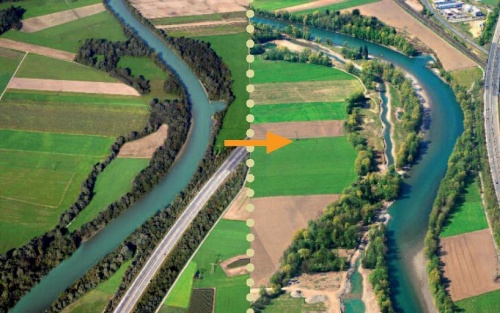Drava - River Widening Amlach/St. Peter
Drava - River Widening Amlach/St. Peter
General description
The Drau river is the fourth longest tributary of the Donau with a length of 707 km. The source of the river is in the Italian municipality Toblach where it continues its flow through Austria, Slovenia, Croatia and Hungary. The mouth of the river in the Donau is near the city of Osijek.
The Upper Drau in Austria is an European protected area with the largest grey alder riparian forests of Austria and over 140 species of birds, including 51 red-listed species. The LIFE project ‘Life vein – Upper Drau River’ was carried out to counteract the trend of too narrow channels that are vulnerable for erosion and flooding by widening the river. Location Amlach/St. Peter is close to the village of Unteramlach and St. Peter, downstream of Spittal an der Drau.
Pressures and Drivers
The Upper Drau is the last free-flowing, not dammed stretch of the river Drau. Nevertheless, human activity has changed the river and its floodplains. When a rail road line was build through the valley in 1870, regulatory procedures were carried out in order to reduce the flood danger and to expand intensive agricultural lands and settlements. The embankments created a narrow channel which suffered from bed erosion. The river bed deepened and wetlands and agricultural lands went dry with the sinking groundwater level. The stability of bank protection structures also suffered from the erosion.
Global objectives
The project has 4 global objectives
- Further stabilization of the Drau river bed through widening and strengthening of bed load influx from tributary brooks.
- More pristine, dynamic shaped river habitats
- Improved information and visitor management on site
- International cooperation with the respective authorities of the Drau neighboring states
Specific objectives
No specific objectives could be found in the available project documents
Success Criteria
No success criteria could be found in the available project documents
Site description
Amlach/St. Peter before (2009) and after completion in 2011. Taken from Life vein – Upper Drau River (2011)
Measures selection
In Amlach/St. Peter, the river bed was widened with 20 meters by moving 60,000 cubic meters of soil and gravel. New wetlands and water bodies were constructed, as well as a new side channel.
Monitoring
Pre-restoration monitoring
A pre-restoration monitoring scheme was carried out to assess the current state of the location. The monitoring focuses on:
- Habitats and animals on the Habitat and Birds Directive
- Fish (presence of species and number of individuals)
- Carabid beetles and other macro-invertebrates (number of species)
- Amphibians (number of individuals)
- River morphology (soil depth and flow velocity)
Post-restoration monitoring
The same indicators used in the pre-restoration monitoring were monitored during the post-monitoring program in 2010 and 2011
Expectations and Response
It was expected that the new, large side channel would create a valuable sanctuary for many types of fish and amphibians. Two hectares of floodplain forest is expected to develop in the coming decades.
Ecology The synopsis of the monitoring carried out in 2010 and 2011 do not show the monitoring results for the location Amlach/St. Peter for fish. The results of the monitoring for the combined projects of the LIFE project and the older GBK Obere Drau project show that the Grayling (Thymallus thymallus) has increased considerably with a doubling of the caught biomass, but it is still below the values measured in the end of the 1980s. Two species that show no improvement are the Danube salmon (Hucho hucho), which is close to complete extinction in the Upper Drava and self-sustaining reproduction could not be determined. The presence of common nase (Chondrostoma nasus) could only be determined by few individuals, but the population has not improved.
Also for macro-invertebrates no results for the individual project Amlach/St. Peter were presented in the synopsis, but for all the projects 5 new species of spider and 8 species of carabid beetles were found of the total 130 species. Overall, the species richness of spiders and carabid beetles with specialized floodplain species returns.
The number of amphibian species rapidly increased from 1 to 6 species.
Hydro-Morphology
A short period after the river widening in Amlach/St. Peter was completed, hydro-morphological processes affected the system strongly. The river bed responded to the discharge relief of the side channel with large sedimentation of 15 cm. The side channel was widened due to bank erosion to 7 meters and in the upstream part shows many sand and gravel banks.
Cooperation
The project was carried out by the Federal Ministry of Agriculture, Forestry, Environment and Water Management in cooperation with the Carinthian State Government and Torrent and avalanche control, section Carinthia.
The main stakeholders were the land owners of the agricultural lands bordering the Drau river.
Communication
The communication with stakeholders and the general public was diverse. The project was opened with a large ceremony with a large attendance from the general public and politicians. A total of 70 project team meetings, 13 action days and 25 excursions were carried out.
Funding
Approximate cost (total project): €4,600,000
%EU Funding: 32.5 (€1,500,000)
%State: 58.5 (€2,600,000) Federal Ministry of Agriculture, Forestry, Environment and Water Management
%Regional authority: 4.5 (€200,000) Carinthian State Government
%other partners: 4.5 (€200,000) Torrent and avalanche control
Contact
Contact
Name: Norbert Sereign
Role: Project leader
Organization Name:
Organization Type:
Phone-Number: + 43 14762 5301 62312
Email: Norbert.Sereinig@ktn.gv.at
References
Unterlercher, M. and Petutschnig, W. (ed.) (2011) Lebensader Obere Drau: F2. Monitoring Synthesebericht, Amt der Kärntner Landesregierung
Life vein – Upper Drau River (2011)
Websites
Related Measures
- Lower river banks or floodplains to enlarge inundation and flooding
- Improve water retention
- Link flood reduction with ecological restoration
- Initiate natural channel dynamics to promote natural regeneration
- Construct semi-natural/articificial wetlands or aquatic habitats
